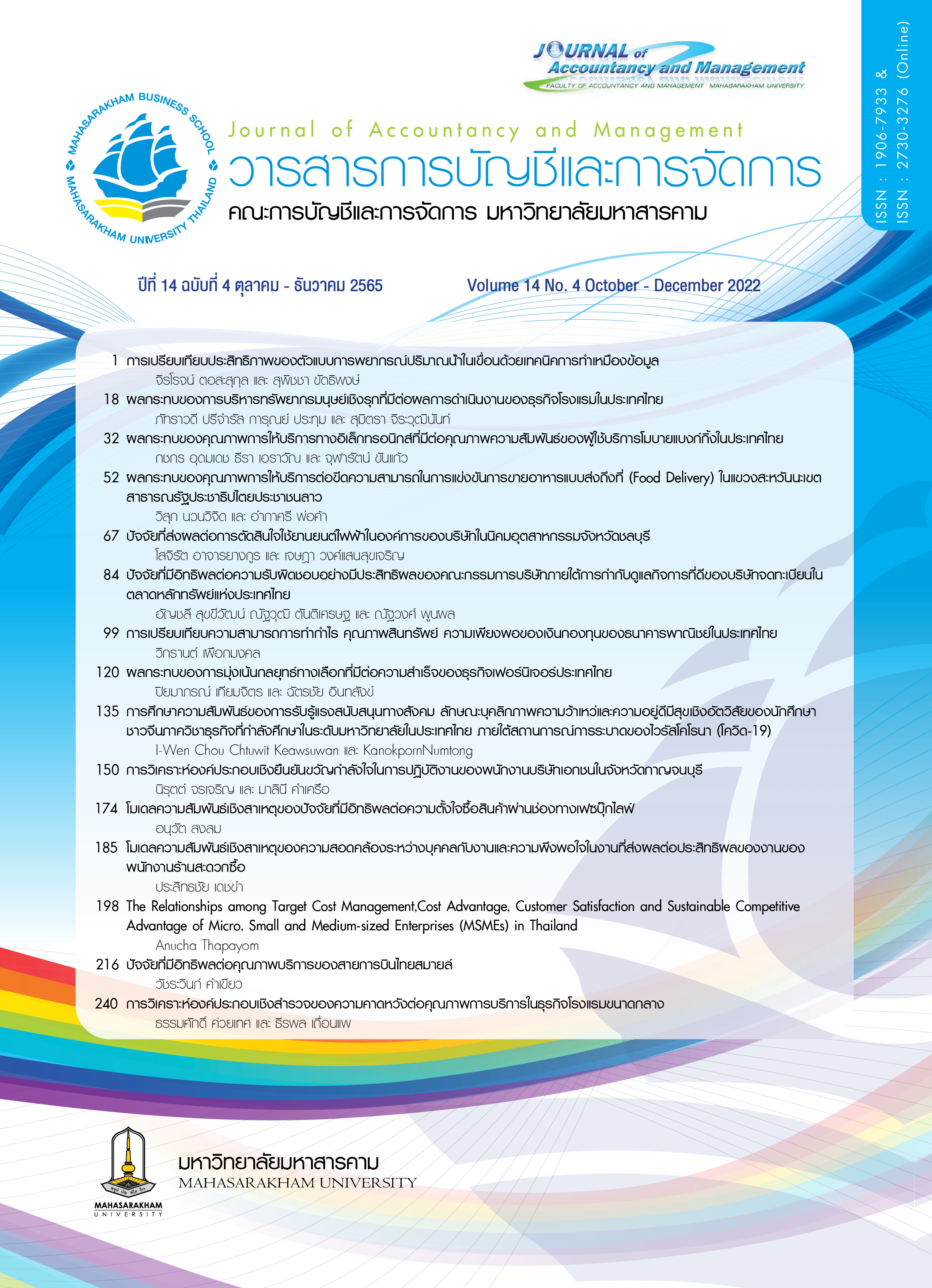การวิเคราะห์องค์ประกอบเชิงยืนยันขวัญกำลังใจในการปฏิบัติงาน ของพนักงานบริษัทเอกชนในจังหวัดกาญจนบุรี
Main Article Content
บทคัดย่อ
งานวิจัยนี้มีวัตถุประสงค์เพื่อ 1) ศึกษาขวัญกำลังใจในการปฏิบัติงานของพนักงานบริษัทเอกชนในจังหวัดกาญจนบุรี 2) วิเคราะห์องค์ประกอบเชิงยืนยันขวัญกำลังใจในการปฏิบัติงานของพนักงานบริษัทเอกชนในจังหวัดกาญจนบุรี และ 3) ตรวจสอบความสอดคล้องของโมเดลขวัญกำลังใจในการปฏิบัติงานของพนักงานบริษัทเอกชนในจังหวัดกาญจนบุรีกับข้อมูลเชิงประจักษ์ กลุ่มตัวอย่าง คือ พนักงานบริษัทเอกชนระดับปฏิบัติการในจังหวัดกาญจนบุรี จำนวน 400 คน จากการสุ่มแบบหลายขั้นตอน เก็บรวบรวมข้อมูลด้วยแบบสอบถาม อธิบายข้อมูลพื้นฐานด้วยสถิติเชิงพรรณนา และวิเคราะห์องค์ประกอบเชิงยืนยันด้วยโปรแกรมสำเร็จรูปในการวิเคราะห์องค์ประกอบ ผลการวิจัยพบว่า ขวัญกำลังใจในการปฏิบัติงานของพนักงานบริษัทเอกชนในจังหวัดกาญจนบุรี ทั้งโดยรวมและรายด้าน พบว่า อยู่ในระดับมากที่สุด ( =4.23, S.D.=0.48) ผลการวิเคราะห์องค์ประกอบเชิงยืนยัน พบว่า ค่าน้ำหนักองค์ประกอบรวมจำนวน 2 องค์ประกอบ มีค่าเป็นบวกและแตกต่างจากศูนย์อย่างมีนัยสำคัญทางสถิติที่ระดับ 0.001 ผลการตรวจสอบความสอดคล้องของโมเดลขวัญกำลังใจในการปฏิบัติงานของพนักงานบริษัทเอกชนในจังหวัดกาญจนบุรีกับข้อมูลเชิงประจักษ์ พบว่า ตัวแปรทั้ง 2 องค์ประกอบ สามารถใช้อธิบายขวัญกำลังใจในการปฏิบัติงานของพนักงานบริษัทเอกชนในจังหวัดกาญจนบุรีได้
เมื่อพิจารณาค่าน้ำหนักองค์ประกอบของตัวแปรสังเกตได้จากข้อคำถามมีค่าระหว่าง 0.79-0.94 เป็นค่าที่ผ่านเกณฑ์ จากค่าสถิติแสดงให้เห็นว่าองค์ประกอบทั้งสองปัจจัยสามารถใช้สร้างขวัญกำลังใจในการปฏิบัติงานของพนักงานบริษัทเอกชนในจังหวัดกาญจนบุรีเป็นไปตามสมมุติฐาน
Downloads
Article Details

อนุญาตภายใต้เงื่อนไข Creative Commons Attribution-NonCommercial-NoDerivatives 4.0 International License.
บทความที่ได้รับการตีพิมพ์เป็นลิขสิทธิ์ของวารสารการบัญชีและการจัดการ
ข้อความที่ปรากฏในบทความแต่ละเรื่องในวารสารวิชาการเล่มนี้เป็นความคิดเห็นส่วนตัวของผู้เขียนแต่ละท่านไม่เกี่ยวข้องกับมหาวิทยาลัยมหาสารคาม และคณาจารย์ท่านอื่นๆในมหาวิทยาลัยฯ แต่อย่างใด ความรับผิดชอบองค์ประกอบทั้งหมดของบทความแต่ละเรื่องเป็นของผู้เขียนแต่ละท่าน หากมีความผิดพลาดใดๆ ผู้เขียนแต่ละท่านจะรับผิดชอบบทความของตนเองแต่ผู้เดียว
เอกสารอ้างอิง
กมลพร กัลยาณมิตร. (2559). แรงจูงใจ 2 ปัจจัย พลังสู่ความสำเร็จ. วารสารวไลยอลงกรณ์ปริทัศน์ (มนุษยศาสตร์และสังคมศาสตร์), 6(3), 175-183.
กรกช วนกรกุล และวรางคนางค์ สกุลวงศ์ ลี หยาน. (2561). ความสัมพันธ์ระหว่างปัจจัยกระตุ้นและปัจจัยบำรุงรักษาตามทฤษฎีสองปัจจัยของเฮิอร์ซ เบิร์กกับความพึงพอใจในงานและความไม่พึงพอใจในงานของผู้ปฏิบัติงานตัวแทนผู้รับจัดการขนส่งสินค้าระหว่างประเทศในองค์กรธุรกิจไทย. วารสารวิชาการ มหาวิทยาลัยหอการค้าไทย มนุษย์ศาสตร์และสังคมศาสตร์, 38(4), 38-51.
กรมการจัดหางาน. (2562). ข้อมูลสถานการณ์ด้านแรงงาน จังหวัดกาญจนบุรี เดือนมีนาคม 2562. ค้นเมื่อ 26 พฤศจิกายน 2562, จาก https://www.doe.go.th/prd/assets/upload/files/lmi_ratchaburi_th/9486b9edb2471cea5f4df18d7b576526.pdf.
กริช แรงสูงเนิน. (2554). การวิเคราะห์ปัจจัยด้วย SPSS และ AMOS เพื่อการวิจัย. กรุงเทพฯ : ซีเอ็ดยูเคชั่น.
กิจจา บานชื่น และกณิกนันต์ บานชื่น. (2559). หลักการจัดการ. กรุงเทพฯ : ซีเอ็ดยูเคชั่น.
จ๊อบซีกเกอร์. (2563). เผย 5 สิ่งสำคัญ มูลเหตุแห่งความก้าวหน้าในหน้าที่การงาน. ค้นเมื่อ 1 กุมภาพันธ์ 2563, จาก https://www.reeracoen.co.th/th/articles/ความก้าวหน้าในหน้าที่การงาน.
ชัชชัย แจ่มจันทร์ ปรีชา เจ็งเจริญ และจักรพันธุ์ วงษ์บูรณาวาทย์. (2558). การวิเคราะห์อิทธิพลของปัจจัยจูงใจ ปัจจัยสุขอนามัย การสื่อสารภายในองค์กร และวัฒนธรรมองค์กร ที่ส่งผลต่อแรงจูงใจของพนักงานภายในองค์การ. ว.มรม. มนุษยศาสตร์และสังคมศาสตร์, 9(3), 75-88.
ฐาปนา ฉิ่นไพศาล. (2559). องค์การและการจัดการ. กรุงเทพฯ : ธนธัชการพิมพ์.
ธานินทร์ ศิลป์จารุ. (2555). การวิจัยและการวิเคราะห์ข้อมูลทางสถิติด้วย SPSS และ AMOS. (พิมพ์ครั้งที่ 13). กรุงเทพฯ : บิสซิเนสอาร์แอนด์ดี.
ธีระพล สุขภาพ. (2555). ขวัญและกำลังใจในการทำงาน. ค้นเมื่อ 20 มีนาคม 2563, จาก https://www.gotoknow.org/posts/3857.
นิรุตต์ จรเจริญ. (2564). การจัดการธุรกิจด้วยเทคโนโลยีดิจิทัล. กรุงเทพฯ : โอ. เอส. พริ้นติ้ง เฮ้าส์.
บุญมา อัครแสง เรืองยศ จันทรสามารถ รังสรรค์ สิงหเลิศ และศักดิ์พงศ์ หอมหวล. (2552). ปัจจัยที่มีผลต่อขวัญกำลังใจในการปฏิบัติงานของเจ้าหน้าที่โรงพยาบาลมหาสารคาม. วารสารมหาวิทยาลัยราชภัฏมหาสารคาม, 3(2), 79-89.
แผนพัฒนาจังหวัดกาญจนบุรี 4 ปี. (2562). แผนพัฒนาจังหวัดกาญจนบุรี 4 ปี (พ.ศ.2561-2564). ค้นเมื่อ 26 พฤศจิกายน 2562, จาก https://ww2.kanchanaburi.go.th/files/com_news_devpro/2018-07_7d27ce7c1dd29ba.pdf.
พิชชาภัสส์ ธนัชญ์จุฑานนท์ และสุวพร เซ็มเฮง. (2556). การสร้างแบบวัดขวัญกำลังใจในการปฏิบัติงานของบุคลากรสายสนับสนุนวิชาการ มหาวิทยาลัยศรีนครินทรวิโรฒ. วารสารวิชาการ Veridian E-Journal, 6(3), 556-570.
ภิราช รัตนันต์. (2560). การพัฒนาโมเดลการรักษาทรัพยากรมนุษย์ร่วมสมัยของธุรกิจอุตสาหกรรมการผลิตที่ใช้แรงงานเป็นหลักในประเทศไทย. วารสารวิชาการและวิจัยสังคมศาสตร์, 12(36), 27-42.
มันนี่ฮับ. (2562). จุดเด่น–จุดด้อย ทำงานบริษัทเอกชน VS รับราชการ. ค้นเมื่อ 26 พฤศจิกายน 2562, จาก https://moneyhub.in.th/article/business-employee-vs-government-officer/.
วรวรรณ เพิ่มทรัพย์. (2558). ความสัมพันธ์ระหว่างขวัญกำลังใจกับความผูกพันต่อองค์การในการปฏิบัติงานของข้าราชการครูสังกัดสำนักงานเขตพื้นที่การศึกษาประถมศึกษาปราจีนบุรีเขต 2. วิทยานิพนธ์ปริญญาการศึกษามหาบัณฑิต สาขาวิชาการบริหารการศึกษา คณะศึกษาศาสตร์ มหาวิทยาลัยบูรพา.
สมชาย ยอดปรางค์ พระเทพปริยัติเมธี และสยาม ดำปรีดา. (2564). ขวัญกำลังใจในการปฏิบัติงานข้าราชการตำรวจชั้นประทวน กองกำกับการตำรวจตระเวนชายแดนที่ 34 จังหวัดตาก. วารสารวิจัยวิชาการ, 4(3), 171-181.
สุมิตร สุวรรณ. (2561). กลยุทธ์การพัฒนาทรัพยากรมนุษย์และองค์การ. นครปฐม: เพชรเกษม พริ้นติ้ง กรุ๊ป.
หทัยทิพย์ เสน่ห์ดุษฎี คาล จามรมาน และเกษมสุข เขียวทอง. (2562). การศึกษาปัจจัยที่ส่งผลต่อความจงรักภักดีต่อองค์กรของพนักงานเจนวายในโรงแรม5 ดาวย่านสุขุมวิท กรุงเทพมหานคร. วารสารวิจัยและพัฒนา วไลยอลงกรณ์ในพระบรมราชูปถัมภ์ สาขามนุษยศาสตร์และสังคมศาสตร์, 14(1), 205-217.
อภิญญา แคล้วเครือ และธีระวัฒน์ จันทึก. (2559). การวิเคราะห์องค์ประกอบปัจจัยของสภาพแวดล้อมในการทำงานเพื่อบรรเทาความเครียด. Veridian E-Journal, Silpakorn University, 9(3), 1563-1579.
Byrne, B. M. (2001). Structural equation modeling with AMOS: Basic concepts, applications, and programming. New Jersey : Lawrence Erlbaum Associates Inc.
Choi, S. L., Goh, C. F., Adam, M., & Tan, O. K. (2016). Transformational Leadership, Empowerment, and Job Satisfaction: the Mediating Role of Employee Empowerment. Human Resources for Health, 14(73), 1-14.
Fisher, R. A. (1950). Statistical methods for research workers. (11th Edition). Edinburgh : Oliver & Boyd.
Hair, J. F., Anderson, R. E., Tatham, R. L., & Black, W. C. (2010). Multivariate Data Analysis. Upper Saddle River, NJ : Pearson Prentice Hall.
Hair, J. F., Ringle, C. M., & Sarstedt, M. (2011). PLS-SEM: Indeed a Silver Bullet. Journal of Marketing Theory and Practice, 19(2), 139–151.
Herzberg, F., et al. (1959). The Motivation to work. New York : John Wiley and Sons.
Kline, R. B. (2005). Principles and practice of structural equation modeling. New York : The Guilford Press.
Nunnally, J. C. & Bernstein, I. H. (1994) The Assessment of Reliability. Psychometric Theory, 3, 248-292.
Rao, A. S. & Abdul, W. K. (2015). Impact of Transformational Leadership on Team Performance: an Empirical Study in UAE. Measuring Business Excellence, 19(4), 30-56.
Likert, R. (1932). A Technique for the Measurement of Attitudes. Archives of Psychology, 140, 1-55.
Yamane, T. (1973). Statistics: An Introductory Analysis. London : John Weather Hill Inc.


